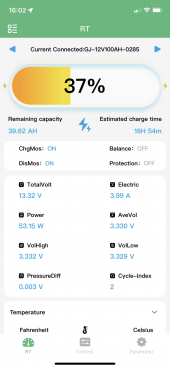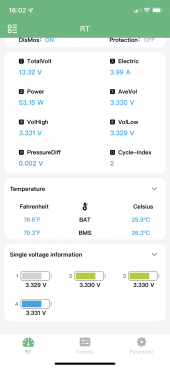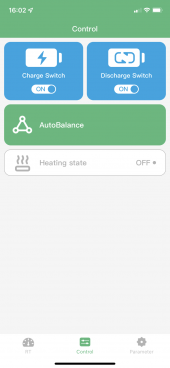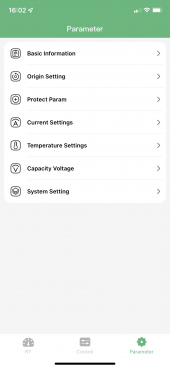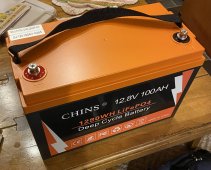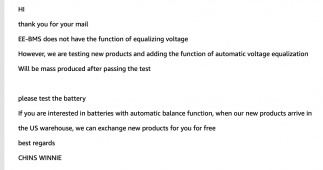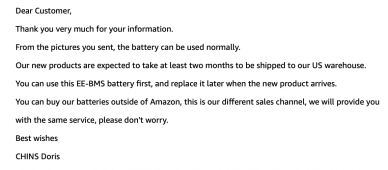electrongeek
New Member
- Joined
- Sep 18, 2021
- Messages
- 13
I recently ordered the Chins Smart 12.8V 100Ah drop-in battery from Amazon for evaluation. This is the version with a heating pad to warm the battery if less than 0 C and Bluetooth BMS interface, and paired with the EE-BMS app. According to the app, it had a tested 105.5 Ah tested capacity and had a manufacture date of October 2021. The battery arrived with a 13.20 V resting voltage, so I put it on my Victron IP65 Blue Smart 15 A charger with a 14.2 V absorption setting and let it go. Unfortunately it went into high voltage protection before absorption was complete This was concerning behavior, since the instructions that come with it specify a 14.2V to 14.6V range for charging. The app showed that one cell hit the 3.750 V cutoff, while the next highest cell was 3.520 V. I went ahead ahead and put it on my Itech electronic load at a 10 A or 0.1C discharge rate, and it delivered 103.3 Ah. Next I charged it with a 14.0 V absorption and it again went into high voltage cutoff with the one cell hitting 3.750 V. After a 15 hour rest period, the high cell was still 0.22 V above the lowest cell voltage. Communication with Chins customer service was prompt, and they agreed to send me a replacement since it exceeded the 0.10 V difference that they considered acceptable.
The replacement that they sent deceived me at first, since unlike the first battery their was no indication that the battery was the "Smart" version, and the EE-BMS app did not connect to it. Customer service again replied within a day to confirm it was the "Smart" version, and that a new app was to be used, BAT-BMS. That did the trick. The new app is much easier to use, since it doesn't require the input of the 666666 password with each use and still provides needed information on cell balance. Unlike the EE-BMS app, there doesn't appear to be a way to change the charging and discharging cutoff parameters, though I don't consider that to be a real problem. This new battery has a March 2022 manufacture date, according to the app, and a 106.9 Ah factory tested capacity. My own test resulted in a 105.5 Ah capacity at 0.1C discharge rate. I was able to charge it with a 14.7 V absorption setting without high voltage cutoff. Bumping absorption up to 14.8 V did result in one cell hitting high voltage cutoff, but that was only after charge rate had dropped to 0.40 A, far lower than the widely held recommendation to terminate charging at an Ampere charge rate of 3% of the bank capacity. At that cutoff, the highest cell was at 3.750 V and the lowest at 3.601 V. After a short 1 hour rest without charging, the difference fell to 0.003 V. The app does have a button for "AutoBalance", but watching the app cell voltages carefully with the total battery voltage in the 14.2 to 14.6 range, I was unable to discern balancing activity. A balance indicator on page 1 of the app always showed "Balance: Off".
I've attached some screen shots of the app during charging. Overall I'm satisfied with this battery, and Chins customer service, but it does point out the advisability of checking each battery's charging and discharging characteristics before putting them into critical service.
The replacement that they sent deceived me at first, since unlike the first battery their was no indication that the battery was the "Smart" version, and the EE-BMS app did not connect to it. Customer service again replied within a day to confirm it was the "Smart" version, and that a new app was to be used, BAT-BMS. That did the trick. The new app is much easier to use, since it doesn't require the input of the 666666 password with each use and still provides needed information on cell balance. Unlike the EE-BMS app, there doesn't appear to be a way to change the charging and discharging cutoff parameters, though I don't consider that to be a real problem. This new battery has a March 2022 manufacture date, according to the app, and a 106.9 Ah factory tested capacity. My own test resulted in a 105.5 Ah capacity at 0.1C discharge rate. I was able to charge it with a 14.7 V absorption setting without high voltage cutoff. Bumping absorption up to 14.8 V did result in one cell hitting high voltage cutoff, but that was only after charge rate had dropped to 0.40 A, far lower than the widely held recommendation to terminate charging at an Ampere charge rate of 3% of the bank capacity. At that cutoff, the highest cell was at 3.750 V and the lowest at 3.601 V. After a short 1 hour rest without charging, the difference fell to 0.003 V. The app does have a button for "AutoBalance", but watching the app cell voltages carefully with the total battery voltage in the 14.2 to 14.6 range, I was unable to discern balancing activity. A balance indicator on page 1 of the app always showed "Balance: Off".
I've attached some screen shots of the app during charging. Overall I'm satisfied with this battery, and Chins customer service, but it does point out the advisability of checking each battery's charging and discharging characteristics before putting them into critical service.



